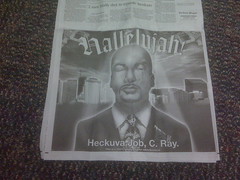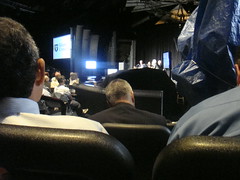Thursday, December 30, 2010
Tuesday, December 14, 2010
Saturday, December 11, 2010
Hostilidays: Shock and Awe
It's that time of year again. Horrible videos all over your Google Reader feed. Leigh, Greg, Mark and more have entries.
Here is the carpet bombing approach to the Hostilidays. Leave no awful video left un-embedded:
Rudolf's Christmas special gets an internet makeover:
Charlie Brown's Heavy Metal Christmas
Little known fact: Bon Jovi's first recording was the Star Wars Christmas Special Album
Another little known fact: the infamous special actually had a plot, as detailed on this entirely too long Wikipedia article.
The Worst Noel:
And the series of tubes brought us the 12 Days of Christmas:
Enjoy. Hope your computer doesn't melt going through all the video.

Here is the carpet bombing approach to the Hostilidays. Leave no awful video left un-embedded:
Rudolf's Christmas special gets an internet makeover:
Charlie Brown's Heavy Metal Christmas
Little known fact: Bon Jovi's first recording was the Star Wars Christmas Special Album
Another little known fact: the infamous special actually had a plot, as detailed on this entirely too long Wikipedia article.
The Worst Noel:
And the series of tubes brought us the 12 Days of Christmas:
Enjoy. Hope your computer doesn't melt going through all the video.

Friday, December 10, 2010
The Montara Blowout: "A failure of sensible oilfield practice 101"
The Montara blowout happened in 2009 in Australia. It was 74 days before well control was re-established, but it was about an order of magnitude smaller than Macondo, so there has been much less scrutiny.
A couple of days ago, the Australian Government released their Report [PDF].
The Oil Drum has a nice summary.
Some interesting notes:
* The report placed the blame almost entirely on PTTEPAA (Thailand's Nationalized Oil Company). Numerous red flags were ignored. The government did not mince words: "the way that PTTEPAA operated the Montara Oilfield did not come within a ‘bulls roar’ of sensible oilfield practice". {Personally, I wonder how much the global shortage of experienced petroleum engineers to supervise projects has played a part in both this blowout and Macondo.}
* Because PTTEPAA is not exactly a household name and no personnel lost their lives, there's been much less attention paid than BP's Macondo Blowout. The Oil Drum says the Aussies should be paying more attention, because it was near the Great Barrier Reef and it could have been a whole lot worse.
* The proximate cause of both disasters was failure of untested cement barriers. Both cement jobs failed to achieve proper zonal isolation, both operators (PTTEPAA and BP) relied on a single barrier to protect them (removal of mud w/o a second cement plug), and failed in well intervention efforts after the well started kicking.
* The cement contractor in both Macondo and Montara: Halliburton. It's interesting to note, though, that the Australian Report completely exonerates Halliburton. {Note that there are also relatively few contractors that do downhole cement. There's Halliburton, BJ Services, Schlumberger, and that's about it. Halliburton provided all of the cement for both relief wells BP drilled, including using their infamous nitrogen-foamed cement [but only on the shallow casings; conventional cement was used to block off Macondo]}.
* The use of dispersants was discussed in the Montara report. They concluded that the use was warranted as the less of two evils.
* In both Macondo and Montara, there were good rules on the books, but nobody, government regulator (MMS) or operator (BP/PTTEPAA) looked at them. In both Macondo and Montara, government regulators would OK whatever the operators asked for in minutes. BP and PTTEPAA's casing engineers totally ignored extensive internal casing design guidelines and operated in a cavalier and ignorant mode of 'git 'er done' without actually knowing what they were doing.
A couple of days ago, the Australian Government released their Report [PDF].
The Oil Drum has a nice summary.
Some interesting notes:
* The report placed the blame almost entirely on PTTEPAA (Thailand's Nationalized Oil Company). Numerous red flags were ignored. The government did not mince words: "the way that PTTEPAA operated the Montara Oilfield did not come within a ‘bulls roar’ of sensible oilfield practice". {Personally, I wonder how much the global shortage of experienced petroleum engineers to supervise projects has played a part in both this blowout and Macondo.}
* Because PTTEPAA is not exactly a household name and no personnel lost their lives, there's been much less attention paid than BP's Macondo Blowout. The Oil Drum says the Aussies should be paying more attention, because it was near the Great Barrier Reef and it could have been a whole lot worse.
* The proximate cause of both disasters was failure of untested cement barriers. Both cement jobs failed to achieve proper zonal isolation, both operators (PTTEPAA and BP) relied on a single barrier to protect them (removal of mud w/o a second cement plug), and failed in well intervention efforts after the well started kicking.
* The cement contractor in both Macondo and Montara: Halliburton. It's interesting to note, though, that the Australian Report completely exonerates Halliburton. {Note that there are also relatively few contractors that do downhole cement. There's Halliburton, BJ Services, Schlumberger, and that's about it. Halliburton provided all of the cement for both relief wells BP drilled, including using their infamous nitrogen-foamed cement [but only on the shallow casings; conventional cement was used to block off Macondo]}.
* The use of dispersants was discussed in the Montara report. They concluded that the use was warranted as the less of two evils.
* In both Macondo and Montara, there were good rules on the books, but nobody, government regulator (MMS) or operator (BP/PTTEPAA) looked at them. In both Macondo and Montara, government regulators would OK whatever the operators asked for in minutes. BP and PTTEPAA's casing engineers totally ignored extensive internal casing design guidelines and operated in a cavalier and ignorant mode of 'git 'er done' without actually knowing what they were doing.
Sunday, December 5, 2010
Saturday, November 20, 2010
Project Truck Update: Preparing for a facelift edition
It's been a long time since I've done a project truck update.
I got back to the truck last weekend. I had neglected to disconnect the ground, so the battery was very weak from a slow leak somewhere. Also, the gasoline had evaporated out the carburetor, so I had to crank the truck enough so the mechanical fuel pump could refill the carburetor reservoir. Patches always rises from the dead eventually, though, like a true zombie.

There's some minor front end damage to the passenger side on Patches, so preping some spare parts for installation is one of my next tasks. The weather has been perfect for painting. Nice and dry.
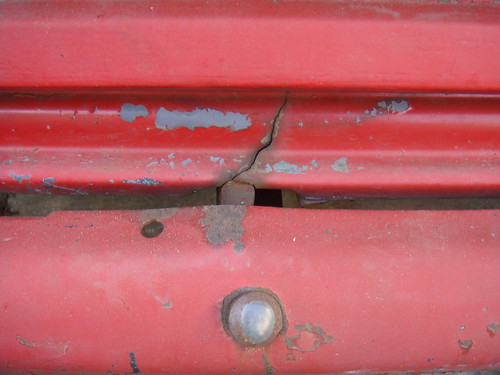
Cracked front body panel
Here's a collection of various spare parts I've picked up, mostly for free:
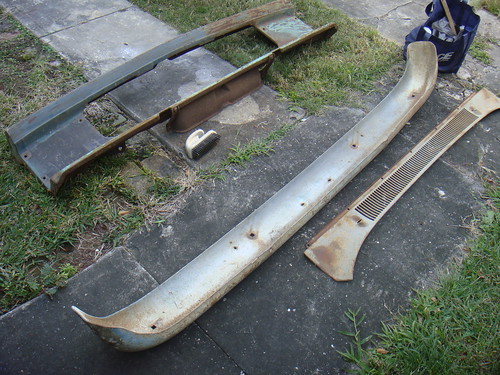
I've got a spare radiator mount cleaned up and primed:
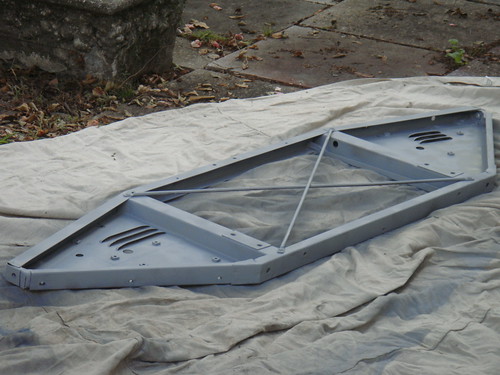
This body panel attaches to the radiator mount:
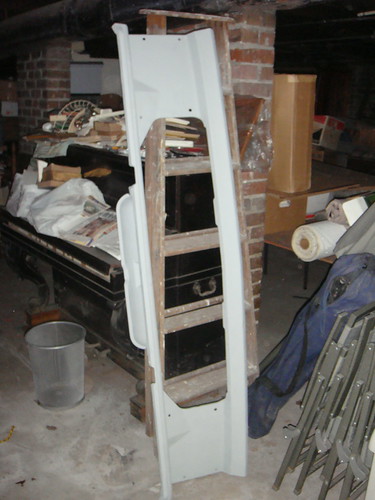
(The grille and headlights connect to it)
I ran out of time before I got to the battery tray, which is yet another item that bolts to the radiator mount:
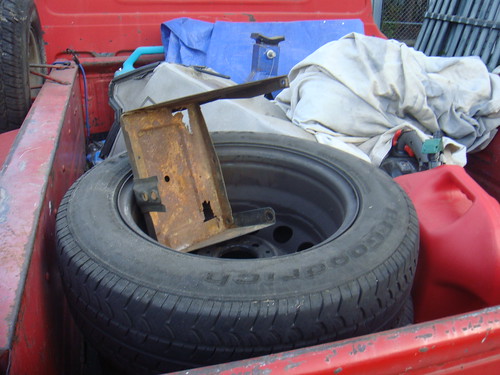
That's the next project.
I got back to the truck last weekend. I had neglected to disconnect the ground, so the battery was very weak from a slow leak somewhere. Also, the gasoline had evaporated out the carburetor, so I had to crank the truck enough so the mechanical fuel pump could refill the carburetor reservoir. Patches always rises from the dead eventually, though, like a true zombie.

There's some minor front end damage to the passenger side on Patches, so preping some spare parts for installation is one of my next tasks. The weather has been perfect for painting. Nice and dry.

Cracked front body panel
Here's a collection of various spare parts I've picked up, mostly for free:

I've got a spare radiator mount cleaned up and primed:

This body panel attaches to the radiator mount:

(The grille and headlights connect to it)
I ran out of time before I got to the battery tray, which is yet another item that bolts to the radiator mount:

That's the next project.
Thursday, November 18, 2010
National Academy of Engineering Preliminary Report on the loss of the Deepwater Horizon
NAE Report (PDF)
Excellent report. I don't have as much time as I'd like to go through it in detail, unfortunately.
A couple quick notes:
* I like how it emphasizes the importance of the delicate fracture gradient to the cementing operation. Any idiot could throw cement down a hole, but with this setup, too much cement (too heavy) would fracture the formation, lose the cement, and not seal the hole. Too little cement, no seal in the hole, boom (what happened). Hitting it right on the nose was what a well engineered cementing plan was supposed to do.
* Personnel shifting around so much is a sign that a company doesn't take something seriously. I watched the engineers testify on CSPAN back in August and I'll say that there was at least 1 engineer who looked like he knew what he was doing (also, the only one who had a P.E.). Unfortunately, he was only on the job for about 2 weeks before the well blew. Whoops.
* Training. OTJ isn't going to cut it anymore for personnel running half-billion dollar assets, drilling $100 million wells, with tens of billions of dollars in consequences for mistakes.

Update: Gullfaks C Report Finished by Statoil. Blowout averted by "sheer luck". After overbalanced drilling caused a poorly-constructed casing to crack, the well lost mud, losing control. Cuttings plugging the production screen was the only thing that stopped another blowout.
Excellent report. I don't have as much time as I'd like to go through it in detail, unfortunately.
A couple quick notes:
* I like how it emphasizes the importance of the delicate fracture gradient to the cementing operation. Any idiot could throw cement down a hole, but with this setup, too much cement (too heavy) would fracture the formation, lose the cement, and not seal the hole. Too little cement, no seal in the hole, boom (what happened). Hitting it right on the nose was what a well engineered cementing plan was supposed to do.
* Personnel shifting around so much is a sign that a company doesn't take something seriously. I watched the engineers testify on CSPAN back in August and I'll say that there was at least 1 engineer who looked like he knew what he was doing (also, the only one who had a P.E.). Unfortunately, he was only on the job for about 2 weeks before the well blew. Whoops.
* Training. OTJ isn't going to cut it anymore for personnel running half-billion dollar assets, drilling $100 million wells, with tens of billions of dollars in consequences for mistakes.

Update: Gullfaks C Report Finished by Statoil. Blowout averted by "sheer luck". After overbalanced drilling caused a poorly-constructed casing to crack, the well lost mud, losing control. Cuttings plugging the production screen was the only thing that stopped another blowout.
Sunday, November 14, 2010
Wednesday, November 3, 2010
The Landrieu Party?
Random observation from yesterday: Every single office of any significance in Louisiana is now held by either a Republican or a Landrieu. The Louisiana Democratic Party is practically extinct. It should be renamed the Landrieu Party.
(Yeah, there's Richmond, but he might not be around that long)
(Yeah, there's Richmond, but he might not be around that long)
Sunday, October 31, 2010
USS Kidd
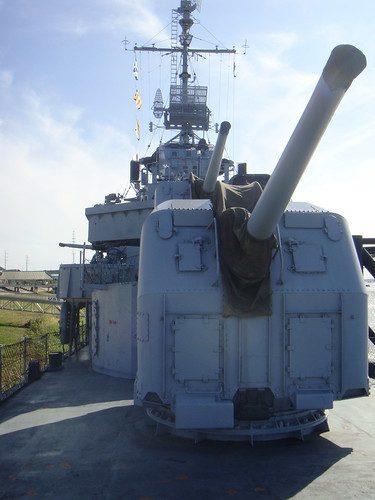
The day before the P.E. exam, I wanted to relax and not do any more studying. I drove to Baton Rouge, scouted out the exam site, and then entertained myself for the afternoon. I went to the Old State Capitol Museum, saw the gun that killed (?) Huey, and checked out the USS Kidd.
The Kidd is a Fletcher-class destroyer from WWII. It survived battles, a Kamikaze, post-war mass-scrappings of ships, age, and has been lovingly restored to it's WWII configuration. It has a unique anchorage that's a big part of why it's in such good condition. Half the year, the vessel floats, but it also rests during low tide on a set of blocks.

The ship dry-docks itself each year, which reduces corrosion and allows for easy maintenance of the hull. There are lots of museum ships that may soon end their lives because of corrosion (see the Olympia and the Texas).
The ship itself is an engineering marvel, which is one of the reasons why I wanted to go the day before the exam. It was built in 1942, but the ship is practically all powerplant (45-Megawatt) underneath the waterline, HUGE propellers has a top speed of 39 knots*. That's a ship that will really move! Part of the key is the "destroyer hullform":
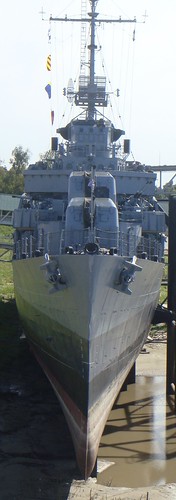
A very narrow, tapered bow that slices through the water. It's not necessarily a great hull for heavy seas (see Typhoon Cobra), but when you want to go fast with reasonable fuel efficiency, accept no substitutes. It's a marvel of naval architecture.
I chatted with a USS Kidd veteran who was on duty at the museum for a while. I mentioned I had stayed on the Kidd when I was in scouts and I was an engineer and was taking the exam tomorrow and he said, "Oh, if you're an engineer, you'll want to see the engine room." JOY! He grabbed the key, and let me go down the ladder to the turbine room (the boiler rooms apparently are still sort of a wreck).
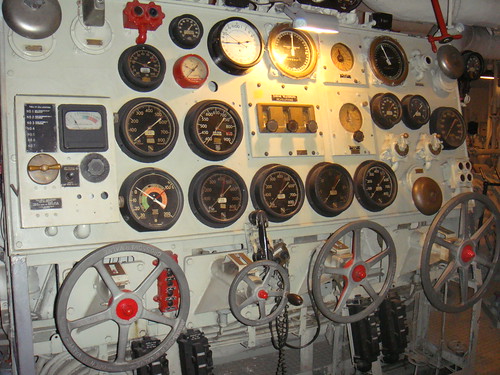
STEAM! VALVES! POWER!
As I left, I did have one sort of sad thought: there's a casino boat right next to the Kidd. How many more visitors does that ship get than the Kidd?
Full Flickr set here.
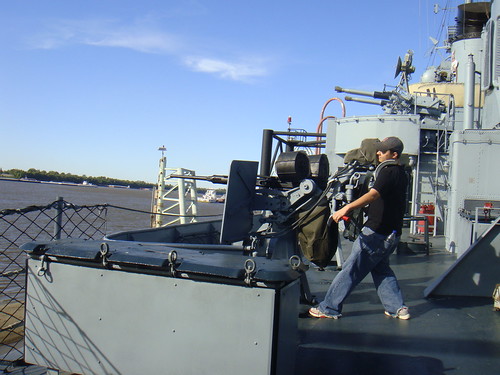
___________________
* 39 knots = 44.8 mph. There is some ambiguity about the exact top speed. The tour guide said 39 knots, the USS Kidd veteran said 39 knots, the USS Kidd website says 37 knots, Wikipedia lists 35-knots for the Fletcher class.
Saturday, October 30, 2010
P. E. Exam Day
Well, yesterday I took the exam. I stayed in a hotel the night before nearby and man, Baton Rouge sure does suck.
I made sure to load up on coffee. I arrived early (they threaten you with not letting you in if you show up late) and the other test takers, being engineers, also showed up early. It was a pretty interesting sight there, all the engineers with their suitcases full of books. Wish I had taken a photo.
One nice thing: the proctors were extremely efficient and courteous. They kept the exam on time (unlike when I took the F.E.) and you didn't notice them during the exam, as it should be.
The exam was flat out hard. There's no other way of putting it. The test makers are extremely paranoid about content being posted, so I'll skip through that. I'll say that there were a few of my strengths that were completely absent from my question bank.
The morning section I was almost finished after 2 1/2 hours. There were a few questions I struggled with the rest of the time.
The afternoon section was far harder than the morning (although it matched up with my areas of expertise more). Each question took much longer. I used all the time allotted to me.
Especially in the afternoon, you've got to move quickly. There's no time to look through solved problems (I tried in the morning and it didn't help). The references that are the best are those that provide shortcuts or are tabulated data. A book full of tabulated data (like Keenan and Keyes or Crane 410) beats out the equations. I now know how all the old farts were able to launch a rocket to the moon with slide rules and all. It was those books of tabulated data. They are awesome and go a long way towards cutting down on calculation errors.
Out of the entire suitcase of books, here's what I actually touched during the exam:
The MERM (all hail the MERM). I also xeroxed the index (3-hole punched and bound, so it met the rules). That saved a lot of time.
Keenan and Keyes Steam Tables
Mark's Standard Handbook. I was able to pull a problem from one of the weirder tables inside.
Keenan's Gas Tables. A book I really, really wished I had studied with more.
Engineering Unit Conversions. A must. Big time saver.
Cameron Hydraulic Data. All the info in Cameron is in the MERM, but Cameron is so much handier. I think I also may have used Crane 410.
Shigley's Machine Design. I think I used it once.
Pocket Ref. Flipped through it for a value on something, I think.
All other texts in my giant suitcase were useless. For all of the code questions (CFR/ASME/etc.), they gave you the section of the code and you had to interpret it.
The best thing I did, honestly, was my own 3-ring binder full of material. I had several psychrometric charts, tons of Wikipedia data on the molecular weight of common gases, etc. I was flipping through that almost as much as the MERM.
I made sure to load up on coffee. I arrived early (they threaten you with not letting you in if you show up late) and the other test takers, being engineers, also showed up early. It was a pretty interesting sight there, all the engineers with their suitcases full of books. Wish I had taken a photo.
One nice thing: the proctors were extremely efficient and courteous. They kept the exam on time (unlike when I took the F.E.) and you didn't notice them during the exam, as it should be.
The exam was flat out hard. There's no other way of putting it. The test makers are extremely paranoid about content being posted, so I'll skip through that. I'll say that there were a few of my strengths that were completely absent from my question bank.
The morning section I was almost finished after 2 1/2 hours. There were a few questions I struggled with the rest of the time.
The afternoon section was far harder than the morning (although it matched up with my areas of expertise more). Each question took much longer. I used all the time allotted to me.
Especially in the afternoon, you've got to move quickly. There's no time to look through solved problems (I tried in the morning and it didn't help). The references that are the best are those that provide shortcuts or are tabulated data. A book full of tabulated data (like Keenan and Keyes or Crane 410) beats out the equations. I now know how all the old farts were able to launch a rocket to the moon with slide rules and all. It was those books of tabulated data. They are awesome and go a long way towards cutting down on calculation errors.
Out of the entire suitcase of books, here's what I actually touched during the exam:
The MERM (all hail the MERM). I also xeroxed the index (3-hole punched and bound, so it met the rules). That saved a lot of time.
Keenan and Keyes Steam Tables
Mark's Standard Handbook. I was able to pull a problem from one of the weirder tables inside.
Keenan's Gas Tables. A book I really, really wished I had studied with more.
Engineering Unit Conversions. A must. Big time saver.
Cameron Hydraulic Data. All the info in Cameron is in the MERM, but Cameron is so much handier. I think I also may have used Crane 410.
Shigley's Machine Design. I think I used it once.
Pocket Ref. Flipped through it for a value on something, I think.
All other texts in my giant suitcase were useless. For all of the code questions (CFR/ASME/etc.), they gave you the section of the code and you had to interpret it.
The best thing I did, honestly, was my own 3-ring binder full of material. I had several psychrometric charts, tons of Wikipedia data on the molecular weight of common gases, etc. I was flipping through that almost as much as the MERM.
Thursday, October 28, 2010
P.E. Exam Tomorrow
I'm in Baton Rouge. Tomorrow, it's me and the MERM (with a few other resources) vs. the P.E. Exam.
Wish me luck.
Wish me luck.
Thursday, October 21, 2010
Race
Took a break from studying to go see "Race", When I first got there, the filmmaker introduced herself with a British accent and then the movie started with lots of Doug Brinkley interviews and I thought, 'oh crap, time to head for the exit'. I stuck around and it thankfully got much better than that.
The later parts of the film featured much less of Brinkley and much more of Jim Carvin, the political consultant who has never lost a mayor's race. He's a fascinating character who can at a instantly dissect both candidates strategies and their chances of victory. Among his main features of advice: run for politics like you're playing golf (stick to the plan, don't get flustered and don't pay attention to what the other guy does).
There was also lots of Nagin. My favorite part was when Nagin interrupts an interview, says, 'hey man, let me tell you about Sun Tzu', reaches into the top drawer of his desk and gingerly pulls out this copy of "The Art of War" that's covered in dog ears and book marks and underlines. The book is falling apart and it looks like he reads the book every single day.
The movie is only 60 minutes long, so there's plenty that's left out, but nothing that really throws the story off too much. If I could give one piece of advice: cut Brinkley's scenes and add much more Carvin.
The later parts of the film featured much less of Brinkley and much more of Jim Carvin, the political consultant who has never lost a mayor's race. He's a fascinating character who can at a instantly dissect both candidates strategies and their chances of victory. Among his main features of advice: run for politics like you're playing golf (stick to the plan, don't get flustered and don't pay attention to what the other guy does).
There was also lots of Nagin. My favorite part was when Nagin interrupts an interview, says, 'hey man, let me tell you about Sun Tzu', reaches into the top drawer of his desk and gingerly pulls out this copy of "The Art of War" that's covered in dog ears and book marks and underlines. The book is falling apart and it looks like he reads the book every single day.
The movie is only 60 minutes long, so there's plenty that's left out, but nothing that really throws the story off too much. If I could give one piece of advice: cut Brinkley's scenes and add much more Carvin.
Wednesday, October 20, 2010
P.E. Exam - Still Studying
8 days left until the trek to Baton Rouge for the exam... Still buried in engineering books...
Monday, August 30, 2010
P.E. Exam, then what next?
Out sick still, so doing a fair amount of posting. I'm still studying. I'm fully registered for October. All I need is to study and take the test.
After all this studying, then what? The P.E. Exam will allow me to stamp drawings (taking on liability for any errors) or work on my own. Even the later is subject so all sorts of caveats. For example, the state of Louisiana prohibits offering engineering services without a license (P.E.), but does allow for the much-maligned "industrial exemption".
Anyway, the P.E. is very important with what I do, but for other industries, the P.E. is useless. I've chatted with a few of my coworkers that work in aerospace, and their companies are all about the Master's degrees, especially if you deal directly with NASA. The NASA employees look down their nose at an engineer that just has an undergrad degree.
Just throwing out random additional ideas:
* Petroleum Engineering/Geology

Petroleum Engineering textbook set I picked up
When times are good, Petroleum Engineering is the highest paying of all engineering professions (when times are not so good, they all go on the unemployment line). I've got the SPE Guide to the P.E. Exam and it seems about 1/3 production system (which I know), 1/3 reservoir engineering (mostly geology), and 1/3 drilling. Now, normally someone who works on drilling would never work on production and visa-versa, but BP has taught me a whole lot about drilling.
* Naval Architecture/Marine Engineering. Recently, I've been working on a lot of offshore and marine systems (ballast systems and the like) and I've found it pretty interesting. If I were to pick up the requesite undergraduate courses, UNO happens to have one of the best NAME programs in the country. Maybe I should look into getting a degree before the Legislature's budget cuts make UNO "ain't dere no more."
* Nuclear. Nukes have always been fascinating to me. It's 20% of our electricity comes from nukes and we actually produce more power, GW(e) to GW(e), than France. I've picked up a guide to the nuclear P.E. test as well.
* Materials Science. There's always a need for a "materials/corrosion guy" on all large projects. An extensive knowledge of materials, galvanic corrosion, welding, etc. It also is a nice balance between specialization and generalization. I don't like the idea of doing just one little niche with no idea on how it fits into the total project. One cool resource: the entire ASM Metals handbook is now online.
After all this studying, then what? The P.E. Exam will allow me to stamp drawings (taking on liability for any errors) or work on my own. Even the later is subject so all sorts of caveats. For example, the state of Louisiana prohibits offering engineering services without a license (P.E.), but does allow for the much-maligned "industrial exemption".
Anyway, the P.E. is very important with what I do, but for other industries, the P.E. is useless. I've chatted with a few of my coworkers that work in aerospace, and their companies are all about the Master's degrees, especially if you deal directly with NASA. The NASA employees look down their nose at an engineer that just has an undergrad degree.
Just throwing out random additional ideas:
* Petroleum Engineering/Geology

Petroleum Engineering textbook set I picked up
When times are good, Petroleum Engineering is the highest paying of all engineering professions (when times are not so good, they all go on the unemployment line). I've got the SPE Guide to the P.E. Exam and it seems about 1/3 production system (which I know), 1/3 reservoir engineering (mostly geology), and 1/3 drilling. Now, normally someone who works on drilling would never work on production and visa-versa, but BP has taught me a whole lot about drilling.
* Naval Architecture/Marine Engineering. Recently, I've been working on a lot of offshore and marine systems (ballast systems and the like) and I've found it pretty interesting. If I were to pick up the requesite undergraduate courses, UNO happens to have one of the best NAME programs in the country. Maybe I should look into getting a degree before the Legislature's budget cuts make UNO "ain't dere no more."
* Nuclear. Nukes have always been fascinating to me. It's 20% of our electricity comes from nukes and we actually produce more power, GW(e) to GW(e), than France. I've picked up a guide to the nuclear P.E. test as well.
* Materials Science. There's always a need for a "materials/corrosion guy" on all large projects. An extensive knowledge of materials, galvanic corrosion, welding, etc. It also is a nice balance between specialization and generalization. I don't like the idea of doing just one little niche with no idea on how it fits into the total project. One cool resource: the entire ASM Metals handbook is now online.
Sunday, August 29, 2010
Rising Tide 5 in the books...
Rising Tide 5 is in the books. I've been sick and Candice had work to do, so we weren't around all that much, but we both made an appearance Friday night and I made it for most of Saturday.
Mac McClelland signing my copy of Halliburton's Cementing Handbook. That's something special.
The venue was great. I liked the setup a lot. There were areas to mill around and talk away from the presentations. That I think is always one of the highlights of Rising Tide. Also, the air conditioning actually worked! Amazing! The lakefront is still my favorite of the Rising Tide venues, thus far.
I decided to not use my flash for my photography, so most of my photos didn't come out well. Oops. I got a couple that came out well.
A few of my takeaways from the Politics panel:
* The focus of the panel was on 2 races: 2nd Congressional (New Orleans) and senate (Vitter/Melancon)
* Crouere: "Bobby Jindal WILL NOT serve two full terms as governor."
* If public universities start shuttering their doors left, right, and center in Louisiana, it will destroy Jindal's reputation both in the state and nationally.
* 2nd Congressional will pit "ethically challenged" Richmond vs. Cao, with Cao having a decent shot at reelection. Note that at last year's Rising Tide, the entire panel thought he was toast.
* Vitter should cruise to reelection, despite nobody actually liking the guy (Republican or Democrat). Vitter is a hard worker, but he's also never faced a strong, well-organized opponent. Every single race he's run has been against pitiful competition. Melancon isn't covering himself in glory, thus far. Also, don't be surprised if more damaging revelations about Vitter's past are released right before the election...
* The LA Democratic Party is a mess. Mitch tried to get the previous head of the party sacked and, despite the backing of his sister, failed. There's major division between the "John Breaux Democrats" and the more liberal, more black democrats. Good leadership is needed to keep the two camps pulling in the same direction and that hasn't happened for a long, long time. As a side note, remember that EVERYONE in the state was a Democrat 20 or 30 years ago.
Tim gave a great presentation on "Why can't we get some dam safety?" Related: Dam Failure - Wiki. Note that dams are considered life safety systems, while levees are not and that's written into the law by Congress.
Congrats to Cliff on winning the AshMo Award for the year.
Mac McClelland signing my copy of Halliburton's Cementing Handbook. That's something special.
The venue was great. I liked the setup a lot. There were areas to mill around and talk away from the presentations. That I think is always one of the highlights of Rising Tide. Also, the air conditioning actually worked! Amazing! The lakefront is still my favorite of the Rising Tide venues, thus far.
I decided to not use my flash for my photography, so most of my photos didn't come out well. Oops. I got a couple that came out well.
A few of my takeaways from the Politics panel:
* The focus of the panel was on 2 races: 2nd Congressional (New Orleans) and senate (Vitter/Melancon)
* Crouere: "Bobby Jindal WILL NOT serve two full terms as governor."
* If public universities start shuttering their doors left, right, and center in Louisiana, it will destroy Jindal's reputation both in the state and nationally.
* 2nd Congressional will pit "ethically challenged" Richmond vs. Cao, with Cao having a decent shot at reelection. Note that at last year's Rising Tide, the entire panel thought he was toast.
* Vitter should cruise to reelection, despite nobody actually liking the guy (Republican or Democrat). Vitter is a hard worker, but he's also never faced a strong, well-organized opponent. Every single race he's run has been against pitiful competition. Melancon isn't covering himself in glory, thus far. Also, don't be surprised if more damaging revelations about Vitter's past are released right before the election...
* The LA Democratic Party is a mess. Mitch tried to get the previous head of the party sacked and, despite the backing of his sister, failed. There's major division between the "John Breaux Democrats" and the more liberal, more black democrats. Good leadership is needed to keep the two camps pulling in the same direction and that hasn't happened for a long, long time. As a side note, remember that EVERYONE in the state was a Democrat 20 or 30 years ago.
Tim gave a great presentation on "Why can't we get some dam safety?" Related: Dam Failure - Wiki. Note that dams are considered life safety systems, while levees are not and that's written into the law by Congress.
Congrats to Cliff on winning the AshMo Award for the year.
Saturday, August 28, 2010
4 Years Ago
Four years ago today, my grandfather died at the age of 99. He was my only living grandfather.
He grew up in Mississippi. His father died when he was only 6, so he grew up poor. He always had to work. He remembers delivering the papers that ended WWI. He dreamed of being an architect or an engineer. He used to win architectural drawing contests in the county fair. The Great Depression killed those hopes. He came to New Orleans and started working for a bank. He started sweeping the floors of the bank, but many years later, after marrying my grandmother, and going to night school, he became the president of the bank (Federal Farm Credit Bank, if memory serves).
He always had a passion for tinkering. At first, he didn't feel that he had anyone to pass it along to, since he had three daughters and times were different then. Years later, I come along as the first male grandchild and I'd say we had a special bond. We had lots of trips to the Butterfly. He used to keep a trunk full of slingshots and other assorted contraband for me and my little brother to play with, when out of sight of my mother.
He gave me subscriptions to Popular Science, Popular Mechanics, Scientific American, and whatever else I requested. He taught me the basics of shop.
He rode out Katrina at Lambeth House, since the new management could get their act together before the storm, but NOFD helped them evacuate after. He ended up for a couple of months in Lutcher, LA.
He came back to New Orleans when I did to finish my last semester for Tulane Engineering. We had debates on whether or not it was appropriate, given the state of the city, but he wanted to come back. He dearly loved New Orleans.
I graduated with a Bachelor's of Science in Mechanical Engineering from Tulane and he was there when I walked and got my degree. Despite being wheelchair-bound and not in the best of shape, he made it to McAllister Auditorium. He died three months later. He was pretty sick towards the end, but he had his mind to the end, which is about as much as anyone could ask for.
The photo is the two of us from August 2005. I was interning at an engineering firm on Magazine Street doing mostly drafting work while I prepared for my senior year at Tulane. The drawing is a rail-based launch system so a topsides unit could be rolled onto a barge and then towed offshore to be placed on a platform.
He grew up in Mississippi. His father died when he was only 6, so he grew up poor. He always had to work. He remembers delivering the papers that ended WWI. He dreamed of being an architect or an engineer. He used to win architectural drawing contests in the county fair. The Great Depression killed those hopes. He came to New Orleans and started working for a bank. He started sweeping the floors of the bank, but many years later, after marrying my grandmother, and going to night school, he became the president of the bank (Federal Farm Credit Bank, if memory serves).
He always had a passion for tinkering. At first, he didn't feel that he had anyone to pass it along to, since he had three daughters and times were different then. Years later, I come along as the first male grandchild and I'd say we had a special bond. We had lots of trips to the Butterfly. He used to keep a trunk full of slingshots and other assorted contraband for me and my little brother to play with, when out of sight of my mother.
He gave me subscriptions to Popular Science, Popular Mechanics, Scientific American, and whatever else I requested. He taught me the basics of shop.
He rode out Katrina at Lambeth House, since the new management could get their act together before the storm, but NOFD helped them evacuate after. He ended up for a couple of months in Lutcher, LA.
He came back to New Orleans when I did to finish my last semester for Tulane Engineering. We had debates on whether or not it was appropriate, given the state of the city, but he wanted to come back. He dearly loved New Orleans.
I graduated with a Bachelor's of Science in Mechanical Engineering from Tulane and he was there when I walked and got my degree. Despite being wheelchair-bound and not in the best of shape, he made it to McAllister Auditorium. He died three months later. He was pretty sick towards the end, but he had his mind to the end, which is about as much as anyone could ask for.
The photo is the two of us from August 2005. I was interning at an engineering firm on Magazine Street doing mostly drafting work while I prepared for my senior year at Tulane. The drawing is a rail-based launch system so a topsides unit could be rolled onto a barge and then towed offshore to be placed on a platform.
Thursday, August 26, 2010
5 Years of Keeping Up With the Corps
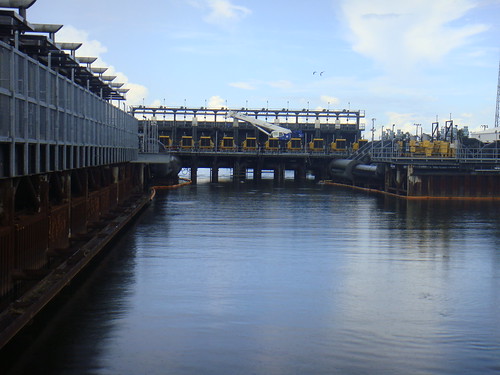
In the five years since the worst failure in the history American Civil Engineering, we've had to keep up with the Corps. They've done some good things since the storm (MR-GO closure, quick and strong repairs) and some not so good things (Option 1 vs. 2a/b debate for permanent pump stations). I'd like to go through 5 major ideas that, depending on how they settle, will determine what sort of levee system we end up with.
1- Design/Build. Shortly after the storm, the Corps decided to issue most of their contracts as Design/Build instead of the Design/Bid/Build, which they've used for decades. Nobody is really sure why the Corps is doing this. I've heard arguments from the Corps saying that they'll get more "creative" designs. I've heard arguments elsewhere saying that the Corps wants someone to throw under the bus in case there is another failure. The Corps also didn't initially free up any money for bid prep work, which meant that bidding firms would spend as little as possible preparing for the bids and would go with very conservative designs they knew how to estimate the cost of. Design/Bid/Build allows you to work the kinks out of the design while still on the drawing board. It's a hell of a lot cheaper to pay a few engineers overtime than have hundreds of workers and field equipment idle while you have to redesign something in the field once construction has begun. In general, I think the design/build approach will lead to excessive cost overruns, but won't make a difference one way or the other on the quality of the work.
2- Resiliency/Backup. One of the points the SELFPA-E has repeatedly made to the Corps when arguing for work on the interior canal walls is what happens if there's a failure of the interim control structure. I have no reason to think there is a design flaw, but if there was, then the flood waters would have a direct path into the city where we know that certain sections of the floodwalls are sub-standard. If the walls are repaired, there would be a second line of defense. The Corps has said that there's no money to do repairs to the existing walls and they can only do what Congress orders them to. The Corps wants to focus all their efforts on Option 1. Now, I will give the Corps credit because there have been several promises made to do at least a modest amount of work upgrading the canal walls at known weak points and that has at least partially mollified SELFPA-E's worries about the canal walls. There is some recognition within the Corps that redundancy is a good thing. OTOH, the Corps can shift some money around and it sort of pokes a hole in their "we do what Congress orders us to do" argument, because otherwise, they wouldn't spend a nickel on canal wall upgrades. From what I understand, it looks like there will be minimally acceptable repairs to canal walls, but many engineering experts, particularly the SELFPA-E would prefer to see more.
3- Geotechnical Analysis. Southeast Louisiana is built on very soft soils and the geotechnical analysis of what sort of loads it can carry is key to any large building project. Most of the geotechnical engineers I know do not believe the Corps' geotech methods are the best that are out there. Furthermore, while I can't say this about the Corps, I have personally seen geotechs put under enormous strain give a "better" answer to allow projects to move forward. The last thing I'll say about geotechnical engineering is it's one of those things in engineering that's still sort of art mixed with science. MIT did a famous study that was presented to ASCE where they constructed a dike, gave a group of eminent geotechnical engineers every single detail about how it was constructed (fill material, depth, volume, etc.) and asked the geotechnical engineers to provide an estimate of how high the water level inside the dike could go before the dike gave way. Of the 7 experts, 5 gave predictions significantly below the level that it failed at, 2 gave level substantially above the level it failed. The geotechnical engineers were given perfect data and no political or economic considerations factored into this test.*
4- B.31.3 Calculations. Matt McBride covered this a few years ago: Post 1 and Post 2. Later, Parsons wrote a report [pdf] that stated the piping is properly designed, per ASME B.31.3 code. It doesn't happen often, but I can say absolutely, definitely, objectively that they are WRONG! I've done those ASME calcs many times before and they are just plain wrong. The consequences aren't all that severe (the piping would probably leak, causing a drop in pressure and lower pumping rates; very small risk of rupture/HSE danger), but it still worries me. If there's a mistake that obvious in something built to tight tolerances, what about more subjective engineering decisions that use materials with wide tolerances?
5- 100 vs. 1000 year protection. As Tim has repeatedly pointed out, "100 Year" protection isn't enough. We need 500 or 1,000 year protection. Furthermore, I have personal questions about how those 100-year levels are computed. The Corps, in the post-Katrina work, has actually built a bit higher than strictly to 100-year protection. For example, some levees have a few extra feet to take subsidence into account and ensure that in a decade or so, the levees will still be well above the 100-year level. Outside the government, I've seen other organizations that have completely revamped what they consider to be a "100 year event". For example, offshore, what used to be considered a 1000-year design is now only considered a 100-year design and as a result, modern construction methods are much, much more robust than they were even just 5 years ago. Don't take my word for it. "Lessons Learned the Hard Way" Page 11 [pdf]: "Yesterday’s 1000-yr criteria have become today’s 100-yr". You can also compare the old API RP's with API 2INT-MET (subsequently integrated into current API RP's).
From all this, I hope everyone sees how important it is to keep an eye on the Corps. Oversight is incredibly important. Note that the SELFPA-E is spending an enormous chunk of their incredibly meager budget to get engineering firms to review the Corps design drawings and calculations. This is important work that must continue.
UPDATE- Minor edits for spelling.
___________________
* Paper: "Reliability of embankment performance predictions" Hynes and Vanmarcke, 1976.
If God Willing and Da Creek Don't Rise
Spike Lee came down and blasted a shotgun at New Orleans. His camera caught the good, the bad, the guilty and the innocent. The main feature of Spike's documentaries is the expansive, if schizophrenic coverage they provide.
Here are a few thoughts:
My absolute favorite part of the entire thing was how they covered the plight of the elderly. More than whites or blacks the elderly had it the worst of anyone. Too many stayed in their homes in Lakeview or elsewhere. They had ridden out Betsy and Camile and just weren't evacuating. Too many drowned in their homes. Many more just had more change and chaos than they could take. So many just lost the will to live, more than any physiological illness.
From there, the rest of the film is a mix of the good, the meh, and the atrocious.
The coverage of the levee situation is atrocious. Ivor van Heerden and Brad Pitt are levee experts and Ivor says the reason the Corps is building things right is because the trial lawyers are on their ass! The Corps is given very little chance to speak (for good or for ill), and Dr. Calvin Mackie (the first black engineering professor at Tulane), who was sterling in "When the Levees Broke" dismissing dynamited-levee-conspiracy-theories, was not really referenced.
Good job on covering mental health issues.
The most questionable part of Spike Lee's style is who he decided to put in the film. It's a very mixed bag. John Kerry? Tracie Washington and Brinkley do not speak well to Spike Lee's judgment. Fuck Brinkley. Fuck anyone who wants to put a camera, mic, or pen in front of him. In his horrible book, the "Great Deluge", he writes that in 1927, they blew up the levees to flood all of the black people in the Lower 9th Ward. Nope. That's how shitty a historian he is.
IMMENSE smackdown of Warren Riley, et. al. by General Honore for panicking people about snipers and raping babies. Honore showed real leadership (unlike, say NOPD) and put his body in front of panicky soldiers with loaded rifles and told them to stand down and realize they were in an American city. As a post-script, I've been told they later realized that the alleged "sniper" near Charity was the PVSV popping off relieving pressure on a liquid oxygen tank used for the hospital.
Schools, meh. Would have liked some mention that the School Board was in the process of being flushed down the toilet before the storm.
Crime & NOPD. Man, what a disaster.
Nagin and the history question... Nagin was allowed to talk way too long and say way too little.
Ivor is also an expert on mining and oil and gas safety...
Tracie Washington is an expert on Dispersant
The BP part, meh.
Here are a few thoughts:
My absolute favorite part of the entire thing was how they covered the plight of the elderly. More than whites or blacks the elderly had it the worst of anyone. Too many stayed in their homes in Lakeview or elsewhere. They had ridden out Betsy and Camile and just weren't evacuating. Too many drowned in their homes. Many more just had more change and chaos than they could take. So many just lost the will to live, more than any physiological illness.
From there, the rest of the film is a mix of the good, the meh, and the atrocious.
The coverage of the levee situation is atrocious. Ivor van Heerden and Brad Pitt are levee experts and Ivor says the reason the Corps is building things right is because the trial lawyers are on their ass! The Corps is given very little chance to speak (for good or for ill), and Dr. Calvin Mackie (the first black engineering professor at Tulane), who was sterling in "When the Levees Broke" dismissing dynamited-levee-conspiracy-theories, was not really referenced.
Good job on covering mental health issues.
The most questionable part of Spike Lee's style is who he decided to put in the film. It's a very mixed bag. John Kerry? Tracie Washington and Brinkley do not speak well to Spike Lee's judgment. Fuck Brinkley. Fuck anyone who wants to put a camera, mic, or pen in front of him. In his horrible book, the "Great Deluge", he writes that in 1927, they blew up the levees to flood all of the black people in the Lower 9th Ward. Nope. That's how shitty a historian he is.
IMMENSE smackdown of Warren Riley, et. al. by General Honore for panicking people about snipers and raping babies. Honore showed real leadership (unlike, say NOPD) and put his body in front of panicky soldiers with loaded rifles and told them to stand down and realize they were in an American city. As a post-script, I've been told they later realized that the alleged "sniper" near Charity was the PVSV popping off relieving pressure on a liquid oxygen tank used for the hospital.
Schools, meh. Would have liked some mention that the School Board was in the process of being flushed down the toilet before the storm.
Crime & NOPD. Man, what a disaster.
Nagin and the history question... Nagin was allowed to talk way too long and say way too little.
Ivor is also an expert on mining and oil and gas safety...
Tracie Washington is an expert on Dispersant
The BP part, meh.
Saturday, August 7, 2010
Going into hibernation
Not much posting lately. Lots to study for October.
My application has been accepted by the state and all I have to do is register with NCEES and pay a couple hundred bucks. I haven't registered yet because I'm still not sure what I'll do for the afternoon section. I've narrowed it down to HVAC or Thermofluids. I have until September 16th to decide.
I'm confident I could pass either one, but it's also possible I could fail either one; there's simply so much material on it. I like to explain Mechanical Engineering to people by saying it's "anything that moves" from cars, to refrigeration, to engines, to aircraft, to pumps, etc.
I've got lots more studying to do. I don't even want to think about how many hundreds of hours I'll be putting into this before I'm done. I want to pass on the first try and would HATE to have to do this all over again. I'm not going to lie, it's starting to get old. It wears on a man, doing engineering all day and all night.
To stay motivated, I've had lots of help from Candice and I've also gotten myself a little reward for after the exam:

My application has been accepted by the state and all I have to do is register with NCEES and pay a couple hundred bucks. I haven't registered yet because I'm still not sure what I'll do for the afternoon section. I've narrowed it down to HVAC or Thermofluids. I have until September 16th to decide.
I'm confident I could pass either one, but it's also possible I could fail either one; there's simply so much material on it. I like to explain Mechanical Engineering to people by saying it's "anything that moves" from cars, to refrigeration, to engines, to aircraft, to pumps, etc.
I've got lots more studying to do. I don't even want to think about how many hundreds of hours I'll be putting into this before I'm done. I want to pass on the first try and would HATE to have to do this all over again. I'm not going to lie, it's starting to get old. It wears on a man, doing engineering all day and all night.
To stay motivated, I've had lots of help from Candice and I've also gotten myself a little reward for after the exam:

Thursday, July 29, 2010
Saturday, July 10, 2010
Monday, July 5, 2010
Tulane Law School to begin wholesale grade inflation
Tulane will now tack on 0.3 to every law school student's GPA. Apparently, too many recent grads are unemployed, so law schools across the nation feel like they have to give their students a helping hand. Above the Law has the details.
At least they're not stealing shoes anymore...
[Insert obligatory Cowen and Tulane Engineering comment here; I'll take your suggestions in the comments]
At least they're not stealing shoes anymore...
[Insert obligatory Cowen and Tulane Engineering comment here; I'll take your suggestions in the comments]
Saturday, July 3, 2010
P.E. Exam Application Status
Sorry the posting has fallen off a bit. I've still got a lot of studying to do.
My application to LAPELS is now complete and it's now "being reviewed by the committee. It takes 6-8 weeks, allegedly. NCEES registration starts on July 6th (Tuesday), but stays open until September. Right now, I'm waiting on LAPELS to give me the OK to register to take the exam. I'm playing a waiting game...
In the meantime, more studying. I'm going through machine design and I'm very glad I still have my old textbooks. Shigley's is fabulous. I've also borrowed Machinery Handbook from a coworker and I've found it really comes in handy. I wish I had bought that instead of Rourke's. It's much easier to find what I need in Machinery Handbook than Rourke's.
After all the machine design problems I've worked, I think I'll stick with either Thermofluids or HVAC for the afternoon section.
My application to LAPELS is now complete and it's now "being reviewed by the committee. It takes 6-8 weeks, allegedly. NCEES registration starts on July 6th (Tuesday), but stays open until September. Right now, I'm waiting on LAPELS to give me the OK to register to take the exam. I'm playing a waiting game...
In the meantime, more studying. I'm going through machine design and I'm very glad I still have my old textbooks. Shigley's is fabulous. I've also borrowed Machinery Handbook from a coworker and I've found it really comes in handy. I wish I had bought that instead of Rourke's. It's much easier to find what I need in Machinery Handbook than Rourke's.
After all the machine design problems I've worked, I think I'll stick with either Thermofluids or HVAC for the afternoon section.
Treme vs. After the Catch
First off: Pistolette reviews Treme. Go read it.
I've been watching Treme and it definitely has its moments, but all in all, I'm finding that quite a few born-and-bred locals, including myself, are lukewarm about it.
------------
Contrast Treme's depiction of New Orleans with Deadliest Catch's "After the Catch". Let's be honest, while Treme is an artistic piece put together by HBO's premier 'auteur', After the Catch is a way for Discovery to milk a few more nickels out of one of the top products, but the results have been fantastic.
For those of you that don't know, this year's ATC is being filmed at the Blue Nile here in New Orleans. Here are some of the funny moments from ATC so far:
* Phil's sons (and all the other captains, as well) talk about New Orleans being the perfect fisherman's town ("The bars! They never close!").
* As opposed to Treme, which beats you over the head with New Orleans culture, ATC just sort of presents it and there it is, like the gumbo cooking segment.
* They had a Chalmatian shrimper on the show and he took Sig and Keith shrimping and, while they didn't catch a thing, they had a blast. What was amazing is Sig, totally unscripted BTW, was blow away by the fact that these fisherman have their house right on the water with the boat tied up by the back and go out shrimping for these big hauls in only 10 or so feet of water. Sig's feeling was, 'that's the life. What have I been doing wrong all these year?' {The obvious, 'Wow, it would be a shame if we lost this' was left for the audience to figure out instead of throwing the brick at them.}

* The same Chalmatian shrimper told the Deadliest Catch captains about surviving Katrina and about how being fishermen is a genetic disorder. While Treme is depicting New Orleanians as running around fucking everyone except who they're supposed to ("Do what you wanna...") with their "defective work ethic", here you have ATC presenting a real, heroic portraits of South Louisianians to Middle America in a way you can honestly be proud of. The guys from the Time Bandit praising Louisiana shrimpers is the best defense against bullshit like this: Michael Savage Calls the Gulf Oil Spill Victims Welfare Deadbeats.
Video of the Deadliest Catch captains being interviewed about their time along the Gulf Coast:
CNN Video
NOTE- Some minor edits after posting.
I've been watching Treme and it definitely has its moments, but all in all, I'm finding that quite a few born-and-bred locals, including myself, are lukewarm about it.
------------
Contrast Treme's depiction of New Orleans with Deadliest Catch's "After the Catch". Let's be honest, while Treme is an artistic piece put together by HBO's premier 'auteur', After the Catch is a way for Discovery to milk a few more nickels out of one of the top products, but the results have been fantastic.
For those of you that don't know, this year's ATC is being filmed at the Blue Nile here in New Orleans. Here are some of the funny moments from ATC so far:
* Phil's sons (and all the other captains, as well) talk about New Orleans being the perfect fisherman's town ("The bars! They never close!").
* As opposed to Treme, which beats you over the head with New Orleans culture, ATC just sort of presents it and there it is, like the gumbo cooking segment.
* They had a Chalmatian shrimper on the show and he took Sig and Keith shrimping and, while they didn't catch a thing, they had a blast. What was amazing is Sig, totally unscripted BTW, was blow away by the fact that these fisherman have their house right on the water with the boat tied up by the back and go out shrimping for these big hauls in only 10 or so feet of water. Sig's feeling was, 'that's the life. What have I been doing wrong all these year?' {The obvious, 'Wow, it would be a shame if we lost this' was left for the audience to figure out instead of throwing the brick at them.}

* The same Chalmatian shrimper told the Deadliest Catch captains about surviving Katrina and about how being fishermen is a genetic disorder. While Treme is depicting New Orleanians as running around fucking everyone except who they're supposed to ("Do what you wanna...") with their "defective work ethic", here you have ATC presenting a real, heroic portraits of South Louisianians to Middle America in a way you can honestly be proud of. The guys from the Time Bandit praising Louisiana shrimpers is the best defense against bullshit like this: Michael Savage Calls the Gulf Oil Spill Victims Welfare Deadbeats.
Video of the Deadliest Catch captains being interviewed about their time along the Gulf Coast:
CNN Video
NOTE- Some minor edits after posting.
Sunday, June 27, 2010
Time to kill the Jones Act?
Recently I've seen a spurt of articles like this: Is the Jones Act lost at sea? and FOX NEWS: Why won't Obama waive the Jones Act?. One of the talking points in a lot of the articles is that oil spill response vessels are being kept away because of the Jones Act, despite specific provisions exempting vessels responding to an oil spill.
That's in part because of a specific exemption in the act that can allow for the use of foreign "oil spill response vessels," said H. Clayton Cook, a Washington attorney and expert on the Jones Act.
"That takes care of your skimmers and your oil spill vessels," he said.
Is the Jones Act, on balance, a good thing or not? Is it protectionist or is it a vital matter of national security? There's way too many facets of such a large law, but I'll talk about the main thrust of the Jones Act (maintaining domestic merchant marine and shipbuilding force).
The Merchant Marine Act of 1920 was authored by Wesley L. Jones (R- Washington) and has been nicknamed the Jones Act ever since. Note that the act has also been revised several times, with large changes made in 1970 and 2006. Here's the preamble to the Jones Act that more or less goes through its purpose and intent:
I've read a few things that have led me to the conclusion that the main thrust of the Jones Act is a good thing (although there's lots of subsets that could probably use a re-write). A couple more things to throw out there:
* All shipbuilding tends to be overbuilt. From Wikipedia's Shipbuilding page: "Historically, the industry has suffered from the absence of global rules and a tendency towards (state-supported) over-investment due to the fact that shipyards offer a wide range of technologies, employ a significant number of workers, and generate foreign currency income (as the shipbuilding market is both global and dollar-based)."
* The purpose of the Jones Act isn't about commerce, so citing examples how much it costs consumers isn't the point. If we let, say, China become THE global shipbuilding power and we have a war (or, more likely, a naval-based trade skirmish) it won't do any good to try and contract with Chinese shipyards to build vessels for the navy. Remember, by definition, the in-place warship building capability is overwhelmed.
* Big multinational companies are the ones pushing the hardest for killing the Jones Act, but lots of local shipbuilding companies are terrified of doing away with it. Aker Shipyards in Philadelphia has a page about the Jones Act. New Orleans City Business had a great article about the Jones Act a while ago where they interviewed reps from local shipyards and service companies who all stated they would be put out of business if foreign companies, with looser engineering, labor, and pollution laws were allowed to come in and compete on their home turf, meanwhile their countries have similar protectionist laws in place the prevent them from competing in foreign lands. The companies interviewed (going off memory; subscription required for City Biz site) included Bollinger, Houma Industries, Hornbeck, and Chouset Offshore.
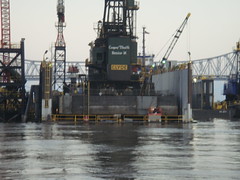
Time to kill the Jones Act? Probably not. If there's a specific problem with it, rewrite that part of the law. Otherwise, leave some fat in the system, because it's way too easy to 'lean' your way to disaster.
Anyway, if anyone has any specific experience with the Jones Act, I'd love to hear it.
UPDATE- Even RigZone calls the Jones Act a red herring, but they fault the USCG for not seizing control of the spill response (non-wellhead intervention) -side of the Macondo Blowout.
That's in part because of a specific exemption in the act that can allow for the use of foreign "oil spill response vessels," said H. Clayton Cook, a Washington attorney and expert on the Jones Act.
"That takes care of your skimmers and your oil spill vessels," he said.
Is the Jones Act, on balance, a good thing or not? Is it protectionist or is it a vital matter of national security? There's way too many facets of such a large law, but I'll talk about the main thrust of the Jones Act (maintaining domestic merchant marine and shipbuilding force).
The Merchant Marine Act of 1920 was authored by Wesley L. Jones (R- Washington) and has been nicknamed the Jones Act ever since. Note that the act has also been revised several times, with large changes made in 1970 and 2006. Here's the preamble to the Jones Act that more or less goes through its purpose and intent:
It is necessary for the national defense and for the proper growth of its foreign and domestic commerce that the United States shall have a merchant marine of the best equipped and most suitable types of vessels sufficient to carry the greater portion of its commerce and serve as a naval or military auxiliary in time of war or national emergency, ultimately to be owned and operated privately by citizens of the United States; and it is declared to be the policy of the United States to do whatever may be necessary to develop and encourage the maintenance of such a merchant marine, and, in so far as may not be inconsistent with the express provisions of this Act, the Secretary of Transportation shall, in the disposition of vessels and shipping property as hereinafter provided, in the making of rules and regulations, and in the administration of the shipping laws keep always in view this purpose and object as the primary end to be attained.
I've read a few things that have led me to the conclusion that the main thrust of the Jones Act is a good thing (although there's lots of subsets that could probably use a re-write). A couple more things to throw out there:
* All shipbuilding tends to be overbuilt. From Wikipedia's Shipbuilding page: "Historically, the industry has suffered from the absence of global rules and a tendency towards (state-supported) over-investment due to the fact that shipyards offer a wide range of technologies, employ a significant number of workers, and generate foreign currency income (as the shipbuilding market is both global and dollar-based)."
* The purpose of the Jones Act isn't about commerce, so citing examples how much it costs consumers isn't the point. If we let, say, China become THE global shipbuilding power and we have a war (or, more likely, a naval-based trade skirmish) it won't do any good to try and contract with Chinese shipyards to build vessels for the navy. Remember, by definition, the in-place warship building capability is overwhelmed.
* Big multinational companies are the ones pushing the hardest for killing the Jones Act, but lots of local shipbuilding companies are terrified of doing away with it. Aker Shipyards in Philadelphia has a page about the Jones Act. New Orleans City Business had a great article about the Jones Act a while ago where they interviewed reps from local shipyards and service companies who all stated they would be put out of business if foreign companies, with looser engineering, labor, and pollution laws were allowed to come in and compete on their home turf, meanwhile their countries have similar protectionist laws in place the prevent them from competing in foreign lands. The companies interviewed (going off memory; subscription required for City Biz site) included Bollinger, Houma Industries, Hornbeck, and Chouset Offshore.

Time to kill the Jones Act? Probably not. If there's a specific problem with it, rewrite that part of the law. Otherwise, leave some fat in the system, because it's way too easy to 'lean' your way to disaster.
Anyway, if anyone has any specific experience with the Jones Act, I'd love to hear it.
UPDATE- Even RigZone calls the Jones Act a red herring, but they fault the USCG for not seizing control of the spill response (non-wellhead intervention) -side of the Macondo Blowout.
Saturday, June 26, 2010
Great Macondo Blowout reporting from an unlikely source...
... A video game show:
Beats some of the stuff the big guys have done.
Beats some of the stuff the big guys have done.
Sunday, June 20, 2010
Yet more studying...
I've done lots of trips to Rue for coffee and studying.
Well, I've put in my application to LAPELS to take the P.E. Exam in October. I'm still awaiting word that the application is 100% complete. They go through the forms with a fine-tooth comb. They give you an extra month after the initial due date to make sure the application is complete.
Next, I'll have to register with NCEES. That's the national board that proctors the actual exam. They have a $150 fee. One thing I just realized is there has been a rule change. Now, when you register in July, you have to pick which subset for the afternoon you want to do on the exam in October. Sort of nuts, if you ask me. It used to be that you could mix and match problems based off what you felt confident or at least you could flip through the books and see what the problems looked like first. Not anymore.
As a MechE, I have 3 choices for the afternoon section:
HVAC
Machine Design
Thermofluids
Machine Design is probably the "easiest", but as I've worked problems, I've found it's entirely too easy to make mistakes on those types of problems. The P.E. Exam is now 100% multiple choice with no credit for just missing a sign or something like that.
HVAC is surprisingly quick. I like that I can get an answer (right or wrong) in a reasonable amount of time for just about any question.
Thermofluids is the closest to what I do at work. It's probably what I'm going to take on the exam, primarily because of my familiarity with it. The disadvantage is that there can be some extremely complicated 15-state thermodynamics problems and even the easiest heat transfer problems take forever to do.
I have to pick what I do in October in July.
-------------
More P.E. news:
Professional engineers provide the needed link between industry and public welfare
NCEES response to the Deepwater Horizon incident. Note that Mark Hafle, BP's engineer that designed the well, is not a P.E.
Well, I've put in my application to LAPELS to take the P.E. Exam in October. I'm still awaiting word that the application is 100% complete. They go through the forms with a fine-tooth comb. They give you an extra month after the initial due date to make sure the application is complete.
Next, I'll have to register with NCEES. That's the national board that proctors the actual exam. They have a $150 fee. One thing I just realized is there has been a rule change. Now, when you register in July, you have to pick which subset for the afternoon you want to do on the exam in October. Sort of nuts, if you ask me. It used to be that you could mix and match problems based off what you felt confident or at least you could flip through the books and see what the problems looked like first. Not anymore.
As a MechE, I have 3 choices for the afternoon section:
HVAC
Machine Design
Thermofluids
Machine Design is probably the "easiest", but as I've worked problems, I've found it's entirely too easy to make mistakes on those types of problems. The P.E. Exam is now 100% multiple choice with no credit for just missing a sign or something like that.
HVAC is surprisingly quick. I like that I can get an answer (right or wrong) in a reasonable amount of time for just about any question.
Thermofluids is the closest to what I do at work. It's probably what I'm going to take on the exam, primarily because of my familiarity with it. The disadvantage is that there can be some extremely complicated 15-state thermodynamics problems and even the easiest heat transfer problems take forever to do.
I have to pick what I do in October in July.
-------------
More P.E. news:
Professional engineers provide the needed link between industry and public welfare
NCEES response to the Deepwater Horizon incident. Note that Mark Hafle, BP's engineer that designed the well, is not a P.E.
Wednesday, June 16, 2010
Tony Hayward Goes Before Congress Tomorrow
Good luck. You're going to need it.

Don't forget to come prepared.
Congress' letter to Tony Hayward. Well worth a read for all the details.
A couple more things to check out:
David Hammer has another fantastic article in today's Times-Pic. He's been a master of presenting the facts in an accurate, understandable way. I can't tell you how frustrated I get when I see some talking head on TV talking about how the well was in water that's "5,000 cubic feet deep" {facepalm}. Just about every article Hammer has cranked out has been great.
GQ Magazine: Boom. Checking in on a few of the lives effected by the explosion, including checking up on the families of the 11. Worth a read, especially the end.
Also, keep reading The Oil Drum for the most accurate, objective reporting on the spill.

Don't forget to come prepared.
Congress' letter to Tony Hayward. Well worth a read for all the details.
A couple more things to check out:
David Hammer has another fantastic article in today's Times-Pic. He's been a master of presenting the facts in an accurate, understandable way. I can't tell you how frustrated I get when I see some talking head on TV talking about how the well was in water that's "5,000 cubic feet deep" {facepalm}. Just about every article Hammer has cranked out has been great.
GQ Magazine: Boom. Checking in on a few of the lives effected by the explosion, including checking up on the families of the 11. Worth a read, especially the end.
Also, keep reading The Oil Drum for the most accurate, objective reporting on the spill.
Friday, June 11, 2010
4 Horsemen Approach South Louisiana?
The demise of South Louisiana has been forecast many times before, but we're now looking at some bleak times.
There is of course the Gusher in the Gulf that just goes on and on, ruining the environment and putting the fisherman out of business. P&J's is hit and almost every single fishing ground in the state will eventually get whacked. So many people in South Louisiana are employed bringing nature's bounty to shore.
There's also the "Economic Nightmare" of the Drilling Moratorium. Thousands of Louisianians are employed working offshore or supporting those offshore (including yours truly) and the rig count is one of the most important factors in the health of the industry. Artificially setting it to zero will have consequences.
Another factor to consider: Avondale Shipyards is looking at tough times. It was once the largest private employer in the state. As recently as the 90's, it was still the 3rd largest employer in the state. Candice's grandfather was one of the many throughout the tiny Acadiana towns to take the bus to the yard. Business is slowing dramatically and while they're OK for now, there's not much on the horizon to give them hope. From what I understand, it's a mixture of factors. First off, Louisiana doesn't have the congressional heft it used to. Landrieu has some swing, but the rest are pathetic and it's a far cry from the days of Breaux, Livingston, Boggs, and even $Bill. Avondale is also a bit of an old yard. It's main advantage is that it's got access to deep draft waterways (the Mississippi has 3, 100'-deep channels all the way up to about Baton Rouge). Northrup-Grumman, which also owns Pascagula, is looking to shift workers to Mississippi, where they have plenty of work for the foreseeable future and a much more modern yard. Northrup-Grumman may even completely close Avondale. Most of the newer US Navy ships tend to be shallower draft, anyway (most of the capital ships started under the 600-ship navy program are still in service with less of a need for replacements at the moment). Here's a nice photo for old-time's sake: USS Iowa passes under the Huey P in 1982.
Finally, Michoud only has a few more E.T.'s left to ship and is facing big job losses.
Oh well, at least there'll be the lawyers suing BP to support the economy (unless of course, the trial gets sent to Houston)...
UPDATE- Avondale Shipyards to close, according to Northrup Grumman.
There is of course the Gusher in the Gulf that just goes on and on, ruining the environment and putting the fisherman out of business. P&J's is hit and almost every single fishing ground in the state will eventually get whacked. So many people in South Louisiana are employed bringing nature's bounty to shore.
There's also the "Economic Nightmare" of the Drilling Moratorium. Thousands of Louisianians are employed working offshore or supporting those offshore (including yours truly) and the rig count is one of the most important factors in the health of the industry. Artificially setting it to zero will have consequences.
Another factor to consider: Avondale Shipyards is looking at tough times. It was once the largest private employer in the state. As recently as the 90's, it was still the 3rd largest employer in the state. Candice's grandfather was one of the many throughout the tiny Acadiana towns to take the bus to the yard. Business is slowing dramatically and while they're OK for now, there's not much on the horizon to give them hope. From what I understand, it's a mixture of factors. First off, Louisiana doesn't have the congressional heft it used to. Landrieu has some swing, but the rest are pathetic and it's a far cry from the days of Breaux, Livingston, Boggs, and even $Bill. Avondale is also a bit of an old yard. It's main advantage is that it's got access to deep draft waterways (the Mississippi has 3, 100'-deep channels all the way up to about Baton Rouge). Northrup-Grumman, which also owns Pascagula, is looking to shift workers to Mississippi, where they have plenty of work for the foreseeable future and a much more modern yard. Northrup-Grumman may even completely close Avondale. Most of the newer US Navy ships tend to be shallower draft, anyway (most of the capital ships started under the 600-ship navy program are still in service with less of a need for replacements at the moment). Here's a nice photo for old-time's sake: USS Iowa passes under the Huey P in 1982.
Finally, Michoud only has a few more E.T.'s left to ship and is facing big job losses.
Oh well, at least there'll be the lawyers suing BP to support the economy (unless of course, the trial gets sent to Houston)...
UPDATE- Avondale Shipyards to close, according to Northrup Grumman.
Wednesday, June 9, 2010
Book Review: Normal Accidents

Normal Accidents: Living with High-Risk Technologies
Recently, while talking about the Deepwater Horizon, someone recommended "Normal Accidents" by Charles Perrow. It's all about Normal Accident Theory [PDF]. The book is filled with all sorts of illustrative examples from a variety of industries (nuclear power, marine transport, aviation, etc.).
There's a huge database of incidents and near-misses. Here's an example from Fix the Pumps on why near misses are important. The most ground breaking part of the book is when he talks about "non-collision course collisions" where two vessels with radar in good weather will come close to each other, but are well away from colliding. Both bridge crews react poorly and the vessels collide, sometimes with deadly consequences (one example was from the Mississippi River near New Orleans - NTSB Report [PDF]).
He also constantly harps on the fact that "operator error", while a constant scapegoat, is actually usually a factor of design flaws or production pressure or something else. Operators get blamed for entirely too much, in Dr. Perrow's opinion. Also, lots of "safety systems" can serve to actually make a complex system more dangerous. Remember, Chernobyl was testing a new safety system the day it blew up. More does not necessarily mean better. If it just adds to the complexity or it requires too much maintenance or it leads to nuisance alarms that cause the operators to miss the real flaw, it's bad. Getting the RIGHT safety system is an important balancing act.
The book has its drawbacks, though. Dr. Perrow is a sociologist, so he gets on some things that, if you have a science or engineering background, you just shake your head at. For example, this edition was last updated in 1999 and he recommends buying a generator to prepare for Y2K. Oops. He also occasionally lets his personal political views push for conclusions beyond strictly what the data (at least as he's presented) supports (ex.- he advocates completely abandoning nuclear power).
There's a lot more to the book, but suffice to say, the book made me think. In the future, I think it will be good for my development as an engineer to ensure that I read at least one engineering disaster book per year.
Monday, June 7, 2010
Monday, May 31, 2010
Sunday, May 23, 2010
4 Years of Engineering
As of yesterday, I've worked as an engineer for 4 years. I graduated on a Saturday, got a job offer Monday, started the Monday after that.
I'm now eligible to take the P.E. Exam. Most states require 5 years of experience before you can take the Principles and Practice in Engineering Exam. Louisiana only requires 4 (and up until this year, you could take it with 3 years, 9 months experience and the time that lapsed between applying and taking the exam an getting the results would take care of the 4 years experience).
The application is due on June 1st and I have everything done. I was just waiting for the official 4 year mark to appear on my experience record, that way there could be no hiccups. You're given an extra month to finalize the application in case of an error or an incomplete application.
I'll take the exam in late October. I've been studying for November and there are times where I'd just prefer to go to the bar and watch baseball. I've gotten pretty frustrated sometimes because, at least for the mechanical exam, there is SO MUCH MATERIAL on the exam.
I've been pretty fortunate in that I've been switched around and gotten lots of experience in different areas; I haven't been pigeonholed doing just one thing. Despite this, I've had nowhere near enough exposure to everything on the exam. The three main areas on the exam are Machine Design, Thermofluids, and HVAC. I've never done any HVAC work and have been teaching that to myself.
The only thing that I've personally worked on enough where I feel like I could take the exam without studying is pumps and piping. Everything else, I have to study. I wonder how hard mechanical engineering is compared to some of the hyper-specific exams like nuclear or petroleum. It's not enough just to know the subject, but you also have to be able to work the problems quickly and efficiently without a computer. So far, I've worked out HVAC problems so quickly that, despite the fact that I've never done that for my job, I'm leaning towards taking that as the "in-depth" portion of the exam.
I'll be making lots of trips to Rue this summer to study...
I'm now eligible to take the P.E. Exam. Most states require 5 years of experience before you can take the Principles and Practice in Engineering Exam. Louisiana only requires 4 (and up until this year, you could take it with 3 years, 9 months experience and the time that lapsed between applying and taking the exam an getting the results would take care of the 4 years experience).
The application is due on June 1st and I have everything done. I was just waiting for the official 4 year mark to appear on my experience record, that way there could be no hiccups. You're given an extra month to finalize the application in case of an error or an incomplete application.
I'll take the exam in late October. I've been studying for November and there are times where I'd just prefer to go to the bar and watch baseball. I've gotten pretty frustrated sometimes because, at least for the mechanical exam, there is SO MUCH MATERIAL on the exam.
I've been pretty fortunate in that I've been switched around and gotten lots of experience in different areas; I haven't been pigeonholed doing just one thing. Despite this, I've had nowhere near enough exposure to everything on the exam. The three main areas on the exam are Machine Design, Thermofluids, and HVAC. I've never done any HVAC work and have been teaching that to myself.
The only thing that I've personally worked on enough where I feel like I could take the exam without studying is pumps and piping. Everything else, I have to study. I wonder how hard mechanical engineering is compared to some of the hyper-specific exams like nuclear or petroleum. It's not enough just to know the subject, but you also have to be able to work the problems quickly and efficiently without a computer. So far, I've worked out HVAC problems so quickly that, despite the fact that I've never done that for my job, I'm leaning towards taking that as the "in-depth" portion of the exam.
I'll be making lots of trips to Rue this summer to study...
Tuesday, May 18, 2010
Deepwater Horizon / Macondo Blowout - Links
I've been a little hesitant to post anything about the Deepwater Horizon/Macondo Blowout. I tend to work on things from the Christmas tree up, but here are a few things to peruse for starters:
The Oil Drum has had some fantastic coverage of the blowout. Probably the best single website when it comes to clear, concise, timely, technically accurate coverage (although RigZone has been pretty good, too).
P.E. writes about about working on rigs and pulls from his vast experience to offer his thoughts.
In the end, the document that should be the most read is the Coast Guard/MMS Board of Inquiry findings. Here's the one for the Ocean Ranger [PDF]. While we can make some very good hypothesis about the technical causes of the blowout and what could be done better to protect the environment and personnel, remember to keep an open mind until all the data is in, especially when the Blowout Preventer is pulled and carefully analyzed on the surface.
60 Minutes. The 60 Minutes piece on the Deepwater Horizon is well worth a watch. It fills in a few holes, but remember it's just a few pieces in the giant puzzle of what went wrong (and for a disaster of this magnitude, there's many, overlapping modes of failure).
Here's a couple of my old posts worth a read, too:
Engineering Disasters: The Demise of the Ocean Ranger
The Offshore Imperative
________________
UPDATE- MMS engineer warned of the danger of deepwater blowouts in 2009. Note that the odds of a deepwater blowout were calculated to be roughly 1 in 400 chance; that's about the same as a Category 5 hurricane destroying our crappy 100-year-level storm protection...
Oil Reaches Shore - Boston.com's Big Picture
The Oil Drum has had some fantastic coverage of the blowout. Probably the best single website when it comes to clear, concise, timely, technically accurate coverage (although RigZone has been pretty good, too).
P.E. writes about about working on rigs and pulls from his vast experience to offer his thoughts.
In the end, the document that should be the most read is the Coast Guard/MMS Board of Inquiry findings. Here's the one for the Ocean Ranger [PDF]. While we can make some very good hypothesis about the technical causes of the blowout and what could be done better to protect the environment and personnel, remember to keep an open mind until all the data is in, especially when the Blowout Preventer is pulled and carefully analyzed on the surface.
60 Minutes. The 60 Minutes piece on the Deepwater Horizon is well worth a watch. It fills in a few holes, but remember it's just a few pieces in the giant puzzle of what went wrong (and for a disaster of this magnitude, there's many, overlapping modes of failure).
Here's a couple of my old posts worth a read, too:
Engineering Disasters: The Demise of the Ocean Ranger
The Offshore Imperative
________________
UPDATE- MMS engineer warned of the danger of deepwater blowouts in 2009. Note that the odds of a deepwater blowout were calculated to be roughly 1 in 400 chance; that's about the same as a Category 5 hurricane destroying our crappy 100-year-level storm protection...
Oil Reaches Shore - Boston.com's Big Picture
Thursday, May 13, 2010
The F-N Diagram
I was going to do a bigger post on this, but I've sort of let it slide, but I didn't want to completely forget about it.
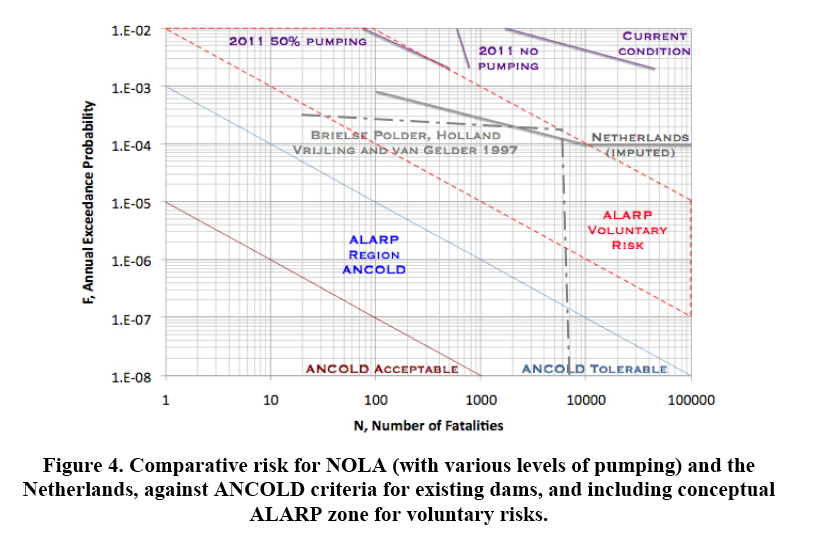
From here: Managing Risk to Humans and to Floodplain Resources (PDF). The chart shows chance of a levee breach on the vertical axis and number of fatalities on the horizontal axis.
When this chart was put up at the Tulane Engineering Forum, the audience took a second to process it (note the log-log scale), but when they did, there was a gasp. It's not every day you see a graph of fatalities on a logarithmic scale. Each line is 10 times worse than the line preceding it. You don't want to see the New Orleans levees in the upper right quadrant of this chart.
The big point I was going to make in the long post I never wrote was we need MUCH more than 100-year level levees.
Related: Residual Risk / YRHT. Very good quote from Dr. Bea.
More here:
Risk-based design of flood defense systems (PDF).
Remember, hurricane season is less than 3 weeks away.
UPDATE- Some minor edits.
UPDATE 2 - Presentations Online

From here: Managing Risk to Humans and to Floodplain Resources (PDF). The chart shows chance of a levee breach on the vertical axis and number of fatalities on the horizontal axis.
When this chart was put up at the Tulane Engineering Forum, the audience took a second to process it (note the log-log scale), but when they did, there was a gasp. It's not every day you see a graph of fatalities on a logarithmic scale. Each line is 10 times worse than the line preceding it. You don't want to see the New Orleans levees in the upper right quadrant of this chart.
The big point I was going to make in the long post I never wrote was we need MUCH more than 100-year level levees.
Related: Residual Risk / YRHT. Very good quote from Dr. Bea.
More here:
Risk-based design of flood defense systems (PDF).
Remember, hurricane season is less than 3 weeks away.
UPDATE- Some minor edits.
UPDATE 2 - Presentations Online
Saturday, May 8, 2010
Wedding Photos are in...
Monday, May 3, 2010
Saturday, May 1, 2010
Don't forget to go vote today
There's a special election for state rep.
Got this attack flier the mail about the Eagle Scout.
Got this attack flier the mail about the Eagle Scout.
Monday, April 19, 2010
How an Engineer Eats Oysters
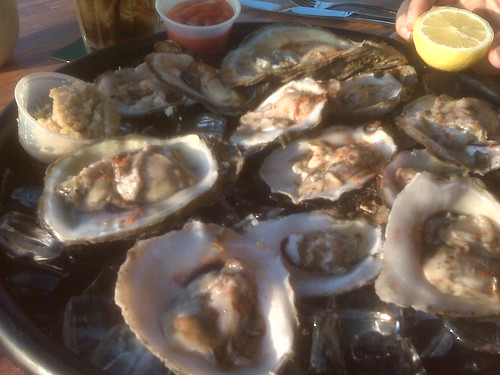
Grasp the lemon in your hand. Firmly squeeze the lemon juice all over the oysters.
Next, mix your cocktail sauce. Add approximately 40/60 ketchup/horseradish and stir. The real judge is the smell and the color. The cocktail sauce should have a pinkish hue.

Next, open a package of crackers. Take one out. Spread on a layer of cocktail sauce 1/8" thick. It should look like this:

Every hole on the cracker should retain some cocktail sauce.
Take your oyster fork and free the little guy from the shell. Place him on the cracker.
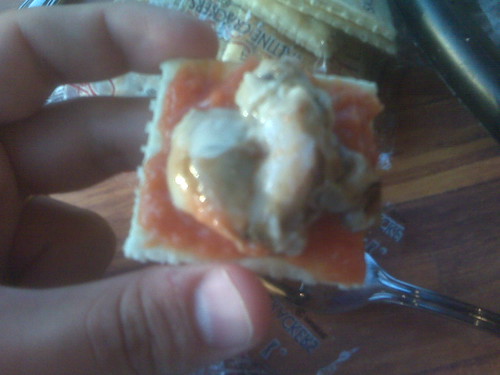
Down the hatch!
Repeat at least 11 times.
Saturday, April 17, 2010
Notes on the 2010 Tulane Engineering Forum
Got a chance to attend the 2010 Tulane Engineering Forum yesterday. It's been evolving into the most interesting engineering conference in the city. There's a good chunk of the city's P.E.'s that attend it every year, including lots of business owners. There's also always at least one presentation every year on the state levees. Partly because of the technical proficiency of the audience, you get some extremely in depth and thorough debate.
Last year's introductory session {PDF} was given by the Corps and I'm told they spent the whole time praising all the things that are being fixed up and all the good things the Corps has done. I'm told that there was some interesting back and forth at the end of their presentation, but I don't know the details, so that's all I'm going to say about that for now.
This year's presentation was by Dr. Dalrymple, Dr. Bolard (PE), Dr. Christian (PE), and Dr. Reed. They were a part of the National Research Council's team that worked for the Corps on LACPR, basically the task force that Congress appointed to design "Category 5 Levees."
As we all know, to date, there is no solid plan for Category 5 Levees. The most up to date thing the Corps came up with was a "menu of options" (111 in total) that was slammed when it came out. The Corps, despite billing themselves as the premier coastal engineers in the country, left it up to Congress to make the ultimate determination of what would get done. While there are some political implications (see Oyster's post), the panel went through some of the scientific and engineering challenges that also pose problems.
First to present was Dr. Dalrymple. His main points were the lack of a "sediment budget" for the lower Mississippi River. The loss of sediment load and sedimentation action is the #1 coastal loss issue, according to him. This was one of his slides:
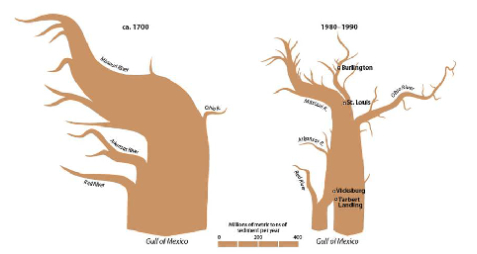
Source
As a side note, if you were to poll the top 100 coastal Louisiana experts on what the biggest problem is, probably 95 would say either canals, primarily for oil and gas exploration, or sediment loss, primarily due to levees confining the Mississippi River. When you have someone from the Corps speak, they tend to play up the canals and when someone from the oil industry speaks, they tend to play up the sediment loss. All four presenters, while nominally affiliated with the Corps, were heavily into the sedimentation camp.
Dr. Dalryrmple went on to comment about to designing a "Category 5 Levee" system. It would be more accurate to describe what New Orleans needs as a 400-1,000 year level of storm protection. No matter what is built, some local cooperation is needed for non-structural mitigation strategies, such as zoning, building codes, and buyouts.
In the end, Dr. Dalrymple held a fairly pessimistic view of the future. When asked what was the NRC's influence on the Corps' plans, Dr. Dalrymple described it as "subtle." The audience of engineers nervously laughed.
Dr. Bolard was the next to present. He once again railed against the failure to take advantage of sediment, both with beneficial use of dredged materials and how we're still directing the majority of the sediment load that comes past the city off the continental shelf into hundreds of feet of water. 125 Million Tons per year of sediment are wasted in this way. Dr. Bolard pointed out that all of the plans from the Corps assume that we'll have basically the same coastline as we do now in 50 years, despite the fact that we lose 24 square miles of coastline per year and that trend has been more or less unchanged for 80+ years! The bulk of Dr. Bolard's remaining presentation was a complicated discussion of the Corps' attempt at using MCDA to whittle down the 111 plans into one or a few actionable items. He described the multiple attempts as failures, for a variety of reasons.
Dr. Christian was next to present and he had by far the best presentation of the group. I'll actually skip over most of his presentation because I want to come back to it in a later post. He mostly talked about the "600-lbs. gorilla in the room: the Corps' performance before during and after Katrina." He started off by listing things that Corps has done into 3 categories: things that have been blamed on the Corps, but aren't really their fault, things the Corps has done well, and thing the Corps has done "not so well."
On the things the Corps gets blamed for, but isn't really their fault, he claimed: split responsibility, Louisiana politics, and a few other minor things. He gave one example of a specific floodgate that has 5 different entities "controlling" it (railroads, roadways, the local levee board, and the Corps). He said that they looked up the operation procedures of each of the organizations and each one assumed that someone else would close the gate in the event of an approaching storm! Also, Louisiana's political scene doesn't do us any favors nationally when hunting for funds to build the levees.
Dr. Christian's list of things the Corps does well were Task Force Guardian, IPET, and the Corps' hydraulics and hydrology understanding. He particularly singled out the Vicksburg office for their understanding of hydrology.
Dr. Chrisian's list of things the Corps does "not-good" was pretty scary. First, he says that all too often you'll have a representative from the Corps, say that the Corps has never had a failure. He says that if you put enough modifiers and adjectives in there, you can get a strictly factual statement, but, in the end, THE LEVEES FAILED!

NOAA via Wikipedia
It's sad to say, but the Corps failed, the Corps failed, the Corps failed. He said it needs to be drilled in that the Corps' levees failed from Katrina's glancing blow under stresses far below their design capacity. The Corps-built levees resulted in the worst civil engineering disaster in American history. Dr. Christian was adamant that that fact not be overlooked in any way.
Dr. Christians other two serious criticisms was the Corps' geotechnical and soils analysis, especially with the New Orleans office is fundamentally flawed. He said that was his professional opinion and that he knew there were lots of people with the Corps that would take strenuous objection to the statement. Note that the debate safe water level in the outfall canals has been extremely contention because of just this issue.
Dr. Christian's last "not so good" Corps procedure was that peer review, while successfully implemented under TF Guardian and IPET, has become a "box-check" and not a real concerted effort. Getting any information out of the Corps is like pulling teeth and there's outright hostility to "outsiders" looking over the Corps' design process.
Dr. Christian made a lot of bold statements, but between the slides and his response to engineers' questions, he seemed to back them up, IMHO.
Dr. Reed was the last one to present. She spoke of the need to manage flood protection, navigation (remember, the reason New Orleans exists), and coastal restoration. We managing the lower delta (where to chop it off) is the big issue for the next 50 years. We don't have the sediment load to preserve everything that exists today, so we need to do some triage. She also mentioned that Mississippi is extremely concerned with any effort to gate the mouth of Lake Pontchartrain because of its effects on Mississippi Gulf Coast storm surges (probably increasing them).
Where does all this leave us? One attendee who saw both plenary sessions (2009 Corps and 2010 NRC/LACPR) described them as presenting "quite a different picture." Currently, we have no plan for Category 5 Levees. The Corps says they'll come out with a plan 'this summer,' but we'll see if/when it comes out and if it's just another "menu" of options. The full presentation will also eventually be uploaded to this page.
NOTE- Minor edits. Also, Dr. Christian praised the Times-Picayune coverage of the situation. He says they've done a better job of informing the locals of the challenges facing the city than anyone has ever given them credit for (and it's not like they've been ignored).
UPDATE- Looks like Mike Schleifstein made it. His article looks along the same lines as mine, but I've got a few more details and he's got a few more links. Also, he caught that the new due date for "Category 5 Levees" is July. I just caught summer.
UPDATE 2 - Presentations Online
UPDATE 3 - The Corps' summer plan is out and it's yet another "Menu of Options"
Last year's introductory session {PDF} was given by the Corps and I'm told they spent the whole time praising all the things that are being fixed up and all the good things the Corps has done. I'm told that there was some interesting back and forth at the end of their presentation, but I don't know the details, so that's all I'm going to say about that for now.
This year's presentation was by Dr. Dalrymple, Dr. Bolard (PE), Dr. Christian (PE), and Dr. Reed. They were a part of the National Research Council's team that worked for the Corps on LACPR, basically the task force that Congress appointed to design "Category 5 Levees."
As we all know, to date, there is no solid plan for Category 5 Levees. The most up to date thing the Corps came up with was a "menu of options" (111 in total) that was slammed when it came out. The Corps, despite billing themselves as the premier coastal engineers in the country, left it up to Congress to make the ultimate determination of what would get done. While there are some political implications (see Oyster's post), the panel went through some of the scientific and engineering challenges that also pose problems.
First to present was Dr. Dalrymple. His main points were the lack of a "sediment budget" for the lower Mississippi River. The loss of sediment load and sedimentation action is the #1 coastal loss issue, according to him. This was one of his slides:

Source
As a side note, if you were to poll the top 100 coastal Louisiana experts on what the biggest problem is, probably 95 would say either canals, primarily for oil and gas exploration, or sediment loss, primarily due to levees confining the Mississippi River. When you have someone from the Corps speak, they tend to play up the canals and when someone from the oil industry speaks, they tend to play up the sediment loss. All four presenters, while nominally affiliated with the Corps, were heavily into the sedimentation camp.
Dr. Dalryrmple went on to comment about to designing a "Category 5 Levee" system. It would be more accurate to describe what New Orleans needs as a 400-1,000 year level of storm protection. No matter what is built, some local cooperation is needed for non-structural mitigation strategies, such as zoning, building codes, and buyouts.
In the end, Dr. Dalrymple held a fairly pessimistic view of the future. When asked what was the NRC's influence on the Corps' plans, Dr. Dalrymple described it as "subtle." The audience of engineers nervously laughed.
Dr. Bolard was the next to present. He once again railed against the failure to take advantage of sediment, both with beneficial use of dredged materials and how we're still directing the majority of the sediment load that comes past the city off the continental shelf into hundreds of feet of water. 125 Million Tons per year of sediment are wasted in this way. Dr. Bolard pointed out that all of the plans from the Corps assume that we'll have basically the same coastline as we do now in 50 years, despite the fact that we lose 24 square miles of coastline per year and that trend has been more or less unchanged for 80+ years! The bulk of Dr. Bolard's remaining presentation was a complicated discussion of the Corps' attempt at using MCDA to whittle down the 111 plans into one or a few actionable items. He described the multiple attempts as failures, for a variety of reasons.
Dr. Christian was next to present and he had by far the best presentation of the group. I'll actually skip over most of his presentation because I want to come back to it in a later post. He mostly talked about the "600-lbs. gorilla in the room: the Corps' performance before during and after Katrina." He started off by listing things that Corps has done into 3 categories: things that have been blamed on the Corps, but aren't really their fault, things the Corps has done well, and thing the Corps has done "not so well."
On the things the Corps gets blamed for, but isn't really their fault, he claimed: split responsibility, Louisiana politics, and a few other minor things. He gave one example of a specific floodgate that has 5 different entities "controlling" it (railroads, roadways, the local levee board, and the Corps). He said that they looked up the operation procedures of each of the organizations and each one assumed that someone else would close the gate in the event of an approaching storm! Also, Louisiana's political scene doesn't do us any favors nationally when hunting for funds to build the levees.
Dr. Christian's list of things the Corps does well were Task Force Guardian, IPET, and the Corps' hydraulics and hydrology understanding. He particularly singled out the Vicksburg office for their understanding of hydrology.
Dr. Chrisian's list of things the Corps does "not-good" was pretty scary. First, he says that all too often you'll have a representative from the Corps, say that the Corps has never had a failure. He says that if you put enough modifiers and adjectives in there, you can get a strictly factual statement, but, in the end, THE LEVEES FAILED!

NOAA via Wikipedia
It's sad to say, but the Corps failed, the Corps failed, the Corps failed. He said it needs to be drilled in that the Corps' levees failed from Katrina's glancing blow under stresses far below their design capacity. The Corps-built levees resulted in the worst civil engineering disaster in American history. Dr. Christian was adamant that that fact not be overlooked in any way.
Dr. Christians other two serious criticisms was the Corps' geotechnical and soils analysis, especially with the New Orleans office is fundamentally flawed. He said that was his professional opinion and that he knew there were lots of people with the Corps that would take strenuous objection to the statement. Note that the debate safe water level in the outfall canals has been extremely contention because of just this issue.
Dr. Christian's last "not so good" Corps procedure was that peer review, while successfully implemented under TF Guardian and IPET, has become a "box-check" and not a real concerted effort. Getting any information out of the Corps is like pulling teeth and there's outright hostility to "outsiders" looking over the Corps' design process.
Dr. Christian made a lot of bold statements, but between the slides and his response to engineers' questions, he seemed to back them up, IMHO.
Dr. Reed was the last one to present. She spoke of the need to manage flood protection, navigation (remember, the reason New Orleans exists), and coastal restoration. We managing the lower delta (where to chop it off) is the big issue for the next 50 years. We don't have the sediment load to preserve everything that exists today, so we need to do some triage. She also mentioned that Mississippi is extremely concerned with any effort to gate the mouth of Lake Pontchartrain because of its effects on Mississippi Gulf Coast storm surges (probably increasing them).
Where does all this leave us? One attendee who saw both plenary sessions (2009 Corps and 2010 NRC/LACPR) described them as presenting "quite a different picture." Currently, we have no plan for Category 5 Levees. The Corps says they'll come out with a plan 'this summer,' but we'll see if/when it comes out and if it's just another "menu" of options. The full presentation will also eventually be uploaded to this page.
NOTE- Minor edits. Also, Dr. Christian praised the Times-Picayune coverage of the situation. He says they've done a better job of informing the locals of the challenges facing the city than anyone has ever given them credit for (and it's not like they've been ignored).
UPDATE- Looks like Mike Schleifstein made it. His article looks along the same lines as mine, but I've got a few more details and he's got a few more links. Also, he caught that the new due date for "Category 5 Levees" is July. I just caught summer.
UPDATE 2 - Presentations Online
UPDATE 3 - The Corps' summer plan is out and it's yet another "Menu of Options"
Sunday, April 11, 2010
Books on Edwin Edwards
One of the things that always frustrates me is learning history that's too recent for the history textbooks, but before I started to regularly read the newspaper. I've been interested in reading up on some recent Louisiana history and the Leo Honeycutt biography caught my eye:

Leo Honeycutt's "Edwin Edwards"
The book features extensive interviews of Edwin Edwards made while he was in prison. Frankly, the book stinks. The beginning is actually quite good and the book covers quite a lot of non-EWE-related Louisiana recent history, which I appreciated. The chronicling of the media's influence on campaigns is one of the best parts of the book. I also like how much the anti-Edwards camp is exposed as hypocrites (Foster for being pro-Duke, pro-gambling and Buddy Roemer for being the "father of legalized gambling in modern Louisiana"). Towards the end, though, the book became unreadably bad. James Gill was quoted extensively, but only at the end when it served the author's bias. There were a couple of quotes that, when a fuller quotation was given, would have conveyed the exact opposite of what Honeycutt was trying to portray. The book also had some minor typographical errors throughout, but for a first edition that was sort of rushed out, I'll forgive. The blatant pro-Edwards bias ruins the book towards the end. I couldn't finish the book, it was that bad.

Tyler Bridges' "Bad Bet on the Bayou"
Instead of finishing Honeycutt's book, I picked up Bad Bet on the Bayou. It is a history of gambling in Louisiana from the Louisiana State Lottery Company to the conviction of Edwin Edwards. The earlier history is fantastic. I loved how it described pre-suburbanization Jefferson Parish as nothing but thugs, scoundrels, and prostitutes. Sometimes, you'll hear suburbanites complain about all the corruption in New Orleans, but the shit that went down in the 'burbs is amazing.
Tyler Bridges really stuck it too Edwards. He got a little too preachy at times. His most effective passage was when he chronicled the damage done by gambling addiction to a half dozen Louisiana families.
After reading both books, first off, I would have never read nearly as much of the Honeycutt book had I read Bridges' book first. I'm also ardently anti-gambling and Bridges' book only reinforced my views. The best way to stop gambling is math education, but if we did that, half the state education budgets would be in the red!
As far as EWE goes, I think that Edwards' first two terms were OK, at least he didn't push gambling. His third was crap, but then again, it was the oil bust, so anyone would have had a hard time. Edwards' fourth term, well, I'll let the man describe it for himself:
"The best thing that could happen to me would be to win the election and die the next day"
-Edwin Edwards to John Maginnis, just before the runoff election against David Duke

Leo Honeycutt's "Edwin Edwards"
The book features extensive interviews of Edwin Edwards made while he was in prison. Frankly, the book stinks. The beginning is actually quite good and the book covers quite a lot of non-EWE-related Louisiana recent history, which I appreciated. The chronicling of the media's influence on campaigns is one of the best parts of the book. I also like how much the anti-Edwards camp is exposed as hypocrites (Foster for being pro-Duke, pro-gambling and Buddy Roemer for being the "father of legalized gambling in modern Louisiana"). Towards the end, though, the book became unreadably bad. James Gill was quoted extensively, but only at the end when it served the author's bias. There were a couple of quotes that, when a fuller quotation was given, would have conveyed the exact opposite of what Honeycutt was trying to portray. The book also had some minor typographical errors throughout, but for a first edition that was sort of rushed out, I'll forgive. The blatant pro-Edwards bias ruins the book towards the end. I couldn't finish the book, it was that bad.

Tyler Bridges' "Bad Bet on the Bayou"
Instead of finishing Honeycutt's book, I picked up Bad Bet on the Bayou. It is a history of gambling in Louisiana from the Louisiana State Lottery Company to the conviction of Edwin Edwards. The earlier history is fantastic. I loved how it described pre-suburbanization Jefferson Parish as nothing but thugs, scoundrels, and prostitutes. Sometimes, you'll hear suburbanites complain about all the corruption in New Orleans, but the shit that went down in the 'burbs is amazing.
Tyler Bridges really stuck it too Edwards. He got a little too preachy at times. His most effective passage was when he chronicled the damage done by gambling addiction to a half dozen Louisiana families.
After reading both books, first off, I would have never read nearly as much of the Honeycutt book had I read Bridges' book first. I'm also ardently anti-gambling and Bridges' book only reinforced my views. The best way to stop gambling is math education, but if we did that, half the state education budgets would be in the red!
As far as EWE goes, I think that Edwards' first two terms were OK, at least he didn't push gambling. His third was crap, but then again, it was the oil bust, so anyone would have had a hard time. Edwards' fourth term, well, I'll let the man describe it for himself:
"The best thing that could happen to me would be to win the election and die the next day"
-Edwin Edwards to John Maginnis, just before the runoff election against David Duke

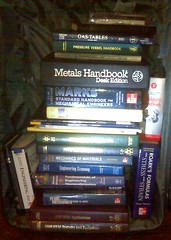

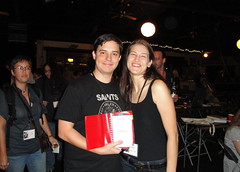



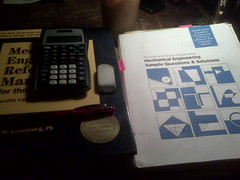

.jpg)
